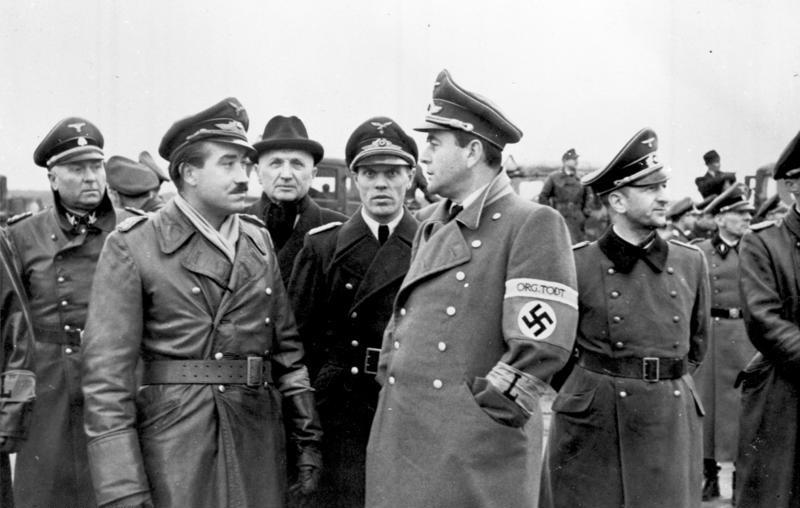- Physical exams conducted by Dr. Thomas of Prisoner 7 in the 1960s showed no signs of the World War I injuries that should have been visible on Hess’ torso. When Thomas questioned Hess as to why the telltale bullet scars were not present, a bizarre reaction followed:
The patient’s manner changed instantly. From being in a sunny, cheerful mood, he turned chalk-white and began to shake. For an instant he stared at me in what appeared bewilderment or even utter disbelief. Then he looked down and avoided my eyes. After what felt like ages he muttered “zu spät, zu spät” (“Too late, too late”).
- The Messerschmitt 110 that Hess piloted to Scotland could only have carried enough fuel to make the flight if it had been equipped with drop tanks. While photographs of Hess’ aircraft in Scotland show drop tanks on the plane, a picture taken by Hess aide Karlheinz Pintsch of the aircraft as it took off from Augsburg air field showed an aircraft outfitted with no such fuel reserves. (Pintsch was eventually captured by the Soviet Army and aggressively interrogated for additional information about Hess’ flight. During the course of this interrogation, all of Pintsch’s fingers were broken.)

drawing of a Messerschmitt 110D showing drop tanks of the kind with which Hess’ aircraft were not equipped
- The flying legend Gen. Adolf Galland who, at the time of Hess’ flight from Germany, commanded the air defense sector through which the aircraft would pass, remarked in his memoirs on one of the “most mysterious affairs” of his career. On the evening of Hess’ flight he was called by Reichsmarschall Göring who excitedly informed him “the Deputy Führer has gone mad!” and ordered Hess’ aircraft be tracked and shot down. Galland, however, noted that the order from Göring came just before dark, well after takeoff and at a point when intercepting Hess’ plane would have been impossible (Thomas believes the delay in ordering Luftwaffe frontier forces scrambled was intentional.). Even more strange was that - despite ordering the intercept - Göring subsequently informed Hitler that he had no knowledge of Hess’ departure. When Dr. Thomas attempted to interview Galland, his requests were rebuffed. (Two years after Hess’ flight, Galland would be placed under house arrest by the Gestapo over his role in a suspected mutiny in the Luftwaffe, but was subsequently exonerated after the personal intervention of Hitler on his behalf.)

Gen. Adolf Galland (left) with Reich Armaments Minister Albert Speer (right) in 1943
Prisoner Seven was subsequently convicted in the Nuremberg Trials on one count of conspiracy and one count of crimes against the peace, but was acquitted of war crimes and crimes against humanity. During the trial he repeatedly claimed he suffered from amnesia and exhibited indifference to the proceedings, spending most court sessions reading a novel. When requested by a French investigator to provide a signature sample, it took Prisoner Seven several attempts - each time he would sign his name he would scratch out the signature before trying again.
Dr. Thomas concluded that Prisoner Seven was not Rudolf Hess, that the real Hess had been eliminated on orders of Heinrich Himmler and replaced with a man of physical similarity as part of a plot by the Party’s hierarchy to overthrow Hitler, perhaps to replace the German government with a SS-centered regime, and that this plot saw the British government as co-conspirators. Prisoner Seven, in Thomas’ analysis, maintained the facade over many decades of imprisonment due to the ever-present threat of Sippenhaft - the system of kin liability that deterred many Germans from testifying in trials of former Nazis even many decades after the end of the war.
The controversial life imprisonment of Prisoner Seven - the last half of which was spent in solitary confinement - was documented in pieces by former prison commandant Lt. Col. Eugene Bird in his 1974 book The Loneliest Man in the World and by former Reich Armaments Minister Albert Speer in his 1976 volume Spandau: The Secret Diaries. Prisoner Seven’s unusual suicide death in 1987 (as rumors of an impending Four-Power agreement to release him gathered momentum) has been alleged by Hess’ son, the late Wolf Hess, and former Spandau nurse Abdallah Melaouhi (neither of whom agreed with the theory of a double), to have been murder by British military intelligence designed to cover a very old and very crucial secret.


No comments:
Post a Comment